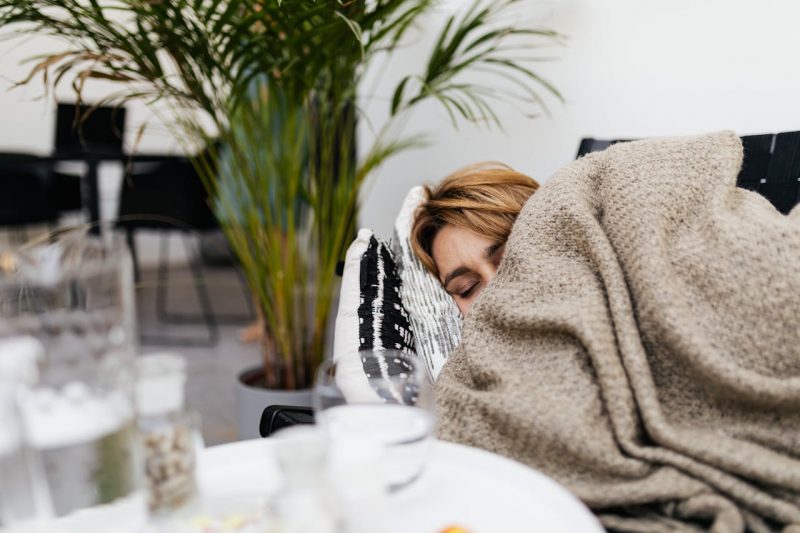
How to Stop Feeling Cold When Fasting and Stay Cozy

Fasting has many benefits, but feeling cold isn’t usually one of them. When the body isn’t digesting food, it can lead to a noticeable drop in temperature, making you feel chilly. This is a common experience, and thankfully, there are several effective strategies to stay warm and comfortable during fasting periods. Here’s how to stop feeling cold when fasting effectively.
Why Does Fasting Make You Feel Cold?
When fasting, the body isn’t actively digesting food, which can decrease metabolic heat production. Eating generates heat as a byproduct of metabolism, so without this process, the body may not produce as much warmth. Additionally, fasting can lead to lower blood sugar levels, which might contribute to a sensation of chilliness.

Karolina Kaboompics | Pexels | Fasting can decrease metabolic heat production, which can make you feel chilly.
How to Stop Feeling Cold When Fasting in 7 Ways
1. Stay Active to Boost Circulation
Physical activity can be a great way to generate body heat. Regular exercise, especially outdoor activities, promotes blood circulation and can help combat the cold. Even light exercises such as walking or stretching can make a noticeable difference. Fresh air can be invigorating, and physical movement stimulates blood flow, naturally warming the body.
2. Dress in Layers
Wearing layers can trap body heat and help you stay warm. Woolen socks, thermal underwear, and cozy sweaters are excellent choices. Layers can be adjusted easily according to comfort and changing temperatures, ensuring that you remain snug without overheating.
3. Hydrate with Warm Beverages
Drinking warm liquids is an effective method to stay cozy. Unsweetened teas, hot water with a squeeze of lemon, or ginger infusions can provide warmth from the inside out. These beverages not only hydrate but also have a comforting effect. Herbal teas, in particular, can be soothing and help maintain a sense of warmth throughout the fasting period.
4. Utilize External Heat Sources
Using external heat sources can be very effective. Warm foot baths are a quick way to warm up, especially before bed. Hot water bottles or heating pads can be used to target specific areas of the body, providing direct warmth. A hot shower or bath can also help raise the body’s core temperature and relieve the cold.
5. Choose Wholesome Foods During Eating Windows
During non-fasting periods, it’s essential to consume wholesome foods that support overall health and warmth. Lean proteins, green vegetables, nuts, and beans are excellent choices. These foods provide the necessary nutrients to maintain energy levels and support metabolic functions. Ensuring a balanced diet during eating windows can help mitigate the cold sensation during fasting.
6. Create a Cozy Environment
Making your environment cozy can significantly enhance comfort. Soft blankets, warm lighting, and a comfortable seating arrangement can create a warm and inviting atmosphere. Keeping the living space comfortable and reducing drafts can also help maintain warmth.
7. Listen to Your Body
It’s important to pay attention to how your body responds to fasting. If the cold sensation persists beyond fasting periods or is unusually intense, it might be worth consulting with a healthcare professional. Persistent cold can sometimes be a sign of underlying health issues that need to be addressed.
More in Life Hacks
-
`
How A Family Crisis Pushed Brad Pitt to Quit Drinking
Brad Pitt hit a wall in 2016. The actor, known for his cool demeanor and A-list charm, found himself in the...
July 27, 2025 -
`
This New York-Based Startup Has Cool Ways of Quitting Cigarettes, Vaping & Zyn
Quitting cigarettes, vaping, and Zyn has always felt clinical, awkward, and kind of lame. But Jones, a New York-based startup, is...
July 18, 2025 -
`
Inside Gwen Stefani’s Life With Her “Greatest Love” Blake Shelton
Gwen Stefani kicked off Blake Shelton’s 49th birthday in the most personal way possible. On June 18, 2025, she shared a...
July 11, 2025 -
`
What Is the Science Behind Out-of-Body Experiences (OBEs)?
Out-of-body experiences, or OBEs, sound like science fiction. But they are real, at least to those who experience them. OBEs involve...
July 5, 2025 -
`
Why Will Smith Regrets Rejecting a Starring Role in “Inception”
Will Smith once passed on a role that would go on to define sci-fi cinema. In a rare moment of honesty,...
June 29, 2025 -
`
5 Things Millionaires Are Doing With Their Money in 2025
Money doesn’t sit still when you are rich. Millionaires don’t hoard it, they grow it. Every dollar has a job to...
June 21, 2025 -
`
‘Living Room Kid’ vs. ‘Bedroom Kid’: The Difference & Parenting Tips
Parenting means learning the little clues that show how your child feels. One major clue? Where your kid spends most of...
June 13, 2025 -
`
5 Ways Morning Meditation Can Boost Your Mental Health
Morning meditation is backed by science and proven to make your brain and body feel better. Right after you wake up,...
June 8, 2025 -
`
Top 10 Best-Dressed Celebs at the 2025 Cannes Film Festival
The 2025 Cannes Film Festival is turning up the glam, but not without surprises. Just a day before the premieres began,...
May 30, 2025
















You must be logged in to post a comment Login